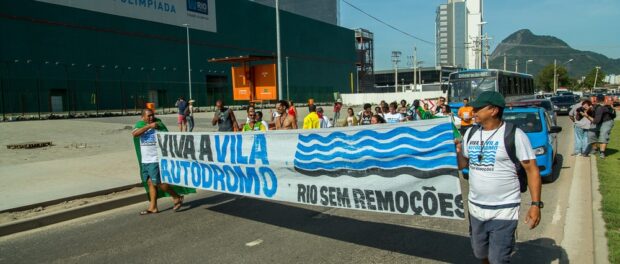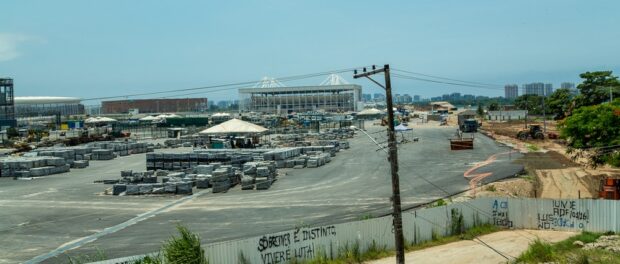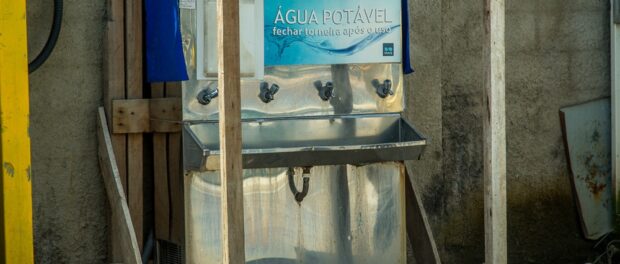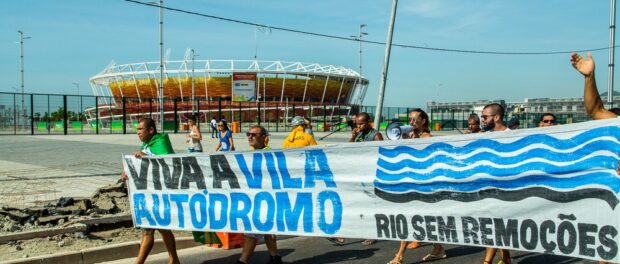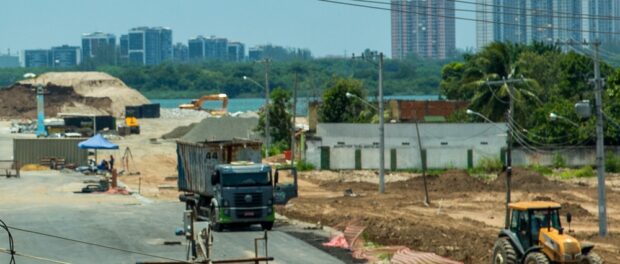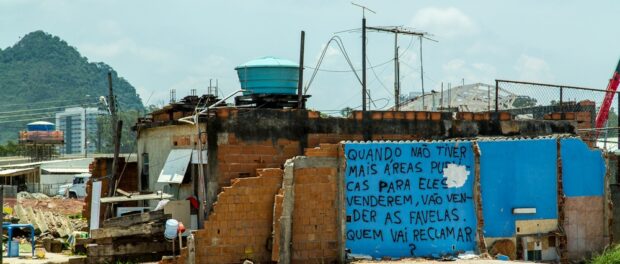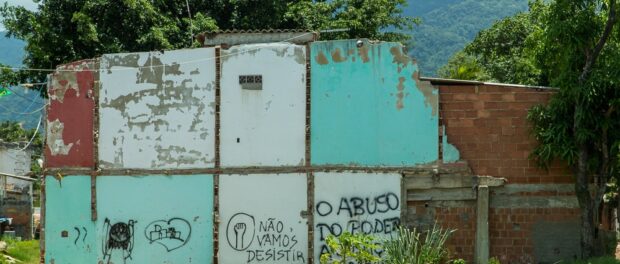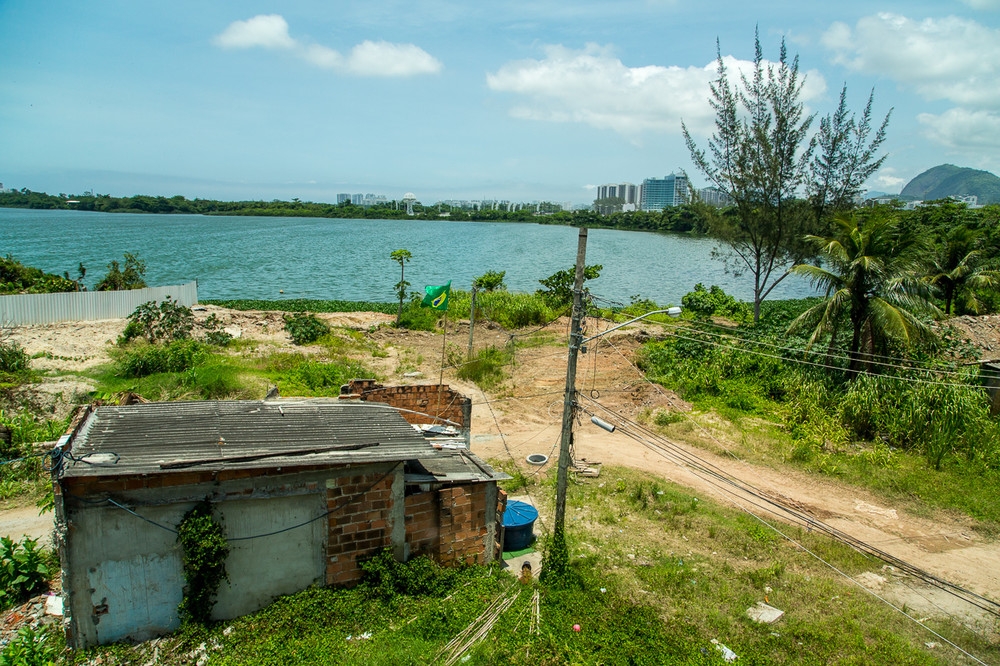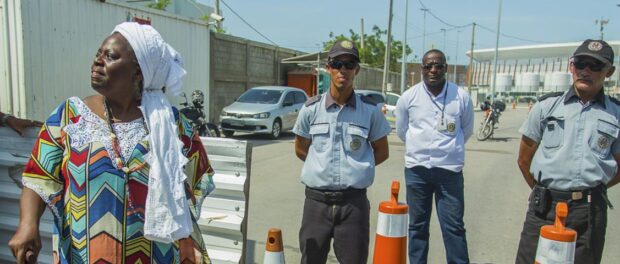
For the original article by Matias Maxx in Portuguese published in VICE click here.
Heloísa Helena Costa Berto, Luizinha of Nanã, is an Afro-Brazilian who has devoted herself to candomblé for over 40 years. For decades, she has served in her spiritual center in Vila Autódromo, on the edge of the Jacarepaguá Lagoon, directly behind the ‘white elephant’ buildings that make up Rio de Janeiro’s Olympic Park. Two years ago, with the intensification of construction work and of the removal of the community, the house began to show signs of cracks and leaks which, together with the chaos of the construction works, made it impossible to continue the spiritual activities that Luizinha practiced there, limiting her work and spiritual help to only her closest friends. Now, nobody is able to access the site without signing in and scheduling an appointment in advance through the sub-mayor’s office of Barra da Tijuca and Jacarepaguá.
After a drawn-out legal battle, the ruling that prevented the demolition of the houses of Heloísa and two other residents was overturned. Even though no repossession court order has been issued, on January 14 a barricade of metal fencing was put up around the road that linked the three houses to the rest of the community. To draw attention to this, Luizinha of Nanã called for a protest on Tuesday, January 26, at which time I was able to talk to her and some of the other Vila Autódromo residents.
Following the protest, I got in touch with Estela, a consultant for Rio Mais Consortium which is overseeing construction of the Olympic Park. She didn’t want to give me much information and would only say that every aspect of the eviction was not being carried out by the consortium, but by the City government: “The whole process of speaking with residents and suggesting where they should go or dealing with compensation is done by the City. Our scope in relation to Vila Autódromo is that there is not scope, we do not work there. The consortium has no involvement there. What we do is the recovery of the strip alongside the lagoon, but nothing is being done there as there are still houses with residents. We will only do the work when the City clears the land; so, we do not answer any disputes concerning Vila Autódromo and the residents, it is all for the City authorities to deal with.”
For one week, via email and making calls, I tried insistently to get hold of representatives of the sub-mayor’s office of Barra and the Olympic Company, which is the City’s body responsible for executing all the municipal projects and activities related to the Rio 2016 Olympic Games and Paralympic Games. I searched for legal clarification concerning the isolation of the three houses, but unfortunately I was not answered.
While I was at the protest, I was able to clearly see the situation. Heloísa’s house, situated on the edge of the lagoon behind the Olympic Park, is separated from the rest of the houses in the community by 200m of dirt road, and beyond that the Park and gigantic hotel complex are being erected. All the residents I spoke to told stories of constant threats and provocation by the militias, City agents and the Municipal Guard. It is not for no reason that Heloísa sleeps with a cell phone and firecrackers nearby to alert the rest of the community in the event that something should happen to her.
Resident Sandra Maria, one of those taking turns on the loud-speaker during the march, described the atmosphere of the community to me: “Several illegal things are going on, and they are always committed with the support of government security guards. Every time they want to do something illegal, the Municipal Guard shock troops come in and prevent residents from taking a stand. Everyone that wanted to leave–or rather, that, in some way, was pressured to leave–either through psychological pressure or through the ruling that they made, has already left… Now, the people here are those who want to stay, and the mayor has said that the people who want to stay can stay; so, he needs to stop committing these crimes, stop with this absurd pressuring by leaving people without electricity and water. What he needs to do now is upgrade and create dignified living conditions for the people that want to stay here. He needs to present the project proposal that he has for the area because there is a proposal, but he is keeping it under lock and key. The only people who know about his project are businessmen linked to the government. Local residents, who should be the first to know about the project, know nothing. What they are actually saying to us is that everyone is going to leave. In the media, the mayor is saying that we will stay, but the government workers here are always saying how everyone is going to go.”

With the houses blocked off, Heloísa, who has difficulty walking and who already used to struggle taking the normal route home, now has to walk almost 1km to identify herself to a guard and then walk another 4km inside the Olympic works’ construction site before finally getting home. The purpose of Tuesday’s protest was to try to make this trip on a particularly sunny day. On arriving at the security guard’s cabin, private security guards informed us that Heloísa could only enter her home by appointment and that visitors were supposed to be registered in advance in the Barra municipal office. Residents asked Captain Duque, who commanded the handful of Military Police escorting the protest, if he would speak to the employees at Rio Mais about the situation, alleging that they were breaking the constitutional right of Heloísa to go to her own home. He was moved a little by this, but after speaking to one of the consortium employees returned saying that he didn’t know the laws involved.
As I mentioned earlier, it was an extremely sunny day, one of those that give meaning to the expression “40 Degree Rio.” We stayed there at the security cabin for approximately two hours waiting for a representative from the consortium. On the other side of the security cabin was an enormous drinking fountain. While we were waiting, the guards would fill the water bottles of the residents and the media who were waiting there. When the representative arrived, he spoke to the police, ignored the residents and then ordered that the guards stop giving water to residents.
I got in touch with Dr. João Helvécio de Carvalho, coordinator of the Land and Housing Nucleus of the Rio de Janeiro Public Defenders Office, who explained that from a legal point of view the case is very complex:
“The most serious of all that is happening is the attitude of the Municipal Guard, the City and Rio Mais to hinder access of the residents to their own homes–such as the case of Heloísa and Marcia who live there even after they put a barricade up in the middle of a public road. According to the report of someone who was inside there, they are landfilling the lagoon. That is, they put the fencing there to hide the view of anything illegal they may be doing there. Besides that, they are blocking the access of these people, so in other words, people have to do a 4km detour to get to their own home. They can’t have guests or receive a delivery from the pharmacy, or an ambulance; they are totally violating the rights of people to remain there.
“The Municipal Guard is there all the time inflicting psychological terror. They are not acting physically, but the psychological violence is constant. Forbidding people to gather, even forbidding them from carrying a Brazilian flag. In other words, there are some gross human rights violations occurring that have very characteristic dictatorial leanings. The Constitution allows the right to meet, to use civic symbols, and the right to come and go, and they are violating all those rights in front of everyone. We are not able to get space in the media, nor are we able to get space with the City authorities, there is no dialogue; the court too, for their part, is very resistant to our aims. The last decision came at a great cost: on the one hand, allowing the demolition of houses where there was consent, and on the other, forbidding the City to make it difficult for people who have not agreed to leave. It is a reasonably favorable decision: the City cannot demolish the houses of people who haven’t agreed to leave and they cannot force people to move from there. There is an order for the removal of rubble and the guarantee of permanency for the people there. But there are [state water utility] CEDAE ducts they are trying to pass through the houses, there are interruptions to the electricity supply, broken sewerage pipes, removal of gutter pipes, it is chaos.”
After the protest, I climbed up onto the roof terrace of Mrs. Penha’s house, one of the few residents still resisting and who became famous after being assaulted by municipal guards during an illegal eviction attempt. On attempting to photograph Heloísa’s house I could see an enormous mound of earth. I am not able to confirm if this pile is the land to fill the lagoon–and, much less, the legality of it–but I mentioned it to Dr. João Helvécio, who told me that they had already notified the Public Ministry. “We are trying to denounce this and take it further: it is more evidence that can be used to call attention to society, because, even though we are talking about human rights violations, people are not reacting much. Now, if we can uncover a threat to the environment there, then perhaps some sectors of society will demand more explanations.” Helvécio also mentioned having met with Dr. Fábio Amado from the Human Rights Nucleus of the Public Defenders Office in order to establish some denouncement strategies including judicial approaches based on human rights law, the constitution, and environmental issues. “We are joining forces to react to this whole situation where the City is pressing so much, and we are not able to keep up.”
The drama of Vila Autódromo is not new, nor is it near an end. In the 1990s, Mayor Cesar Maia was already trying to remove the community–without success. Heloísa says it was at this time that her mother dedicated her house to Nanã, Goddess of the mangroves, swamps and mud. “My saint requires that I stay near the lagoon. She recognizes this house as hers because at the time when my mother came here, when Cesar Maia really wanted to get people out of here, my mother made a promise and gave the house to Nanã, and it was from then on that Nanã considered the house as hers. But now I can no longer practice my religion. If someone calls me needing help, I cannot receive them without registering their visit with the government and on the weekends, for example, the municipal offices are not open. So, I am not able to help that person. That is unconstitutional! And if I have to go out and come back at night when the gate is locked? Can I not get in? They are preventing me from enjoying my own property.”
The scene in the rest of Vila Autódromo is devastating. Noise and dust from construction are constant, and the incessant movement from workers, machinery and materials is transforming the geography daily. The few remaining houses and walls are cracked and covered in writing. Some houses are more humble; others are bigger–the fruit of decades of savings and renovations. The few people who are staying in Vila Autódromo are advanced in age and these houses are the only property they have left. Heloísa explained to me: “Many people of a certain age die when they leave here as they cannot bear to stay far away from here. My godmother was one of them. Many people have died or fallen into a deep depression after leaving here.”
During the long process of relocation, some owners of mechanics workshops in the community managed to receive pay-outs of more than R$2 million, as well as a couple of Military Police officials who lived there and had millions paid out. However, the majority of Vila Autódromo residents, more than 300 families, were simply relocated to the Parque Carioca housing complex, where the apartments are valued at R$150,000, according to an OLX advertisement. In 2013 the mayor declared that residents who wanted to remain in Vila Autódromo could do so, although the atmosphere of abandonment is not very inviting for many. The only thing that the residents are asking for now is upgrading.
On February 27, residents, together with their support network, intend on presenting their Vila Autódromo People’s Plan. The idea is to increase pressure and ask for the start of upgrading and the demarcation of plots. Those invited to the event include the mayor, the governor and President Dilma, as well as the Rio de Janeiro State Institute for Land and Cartography.

